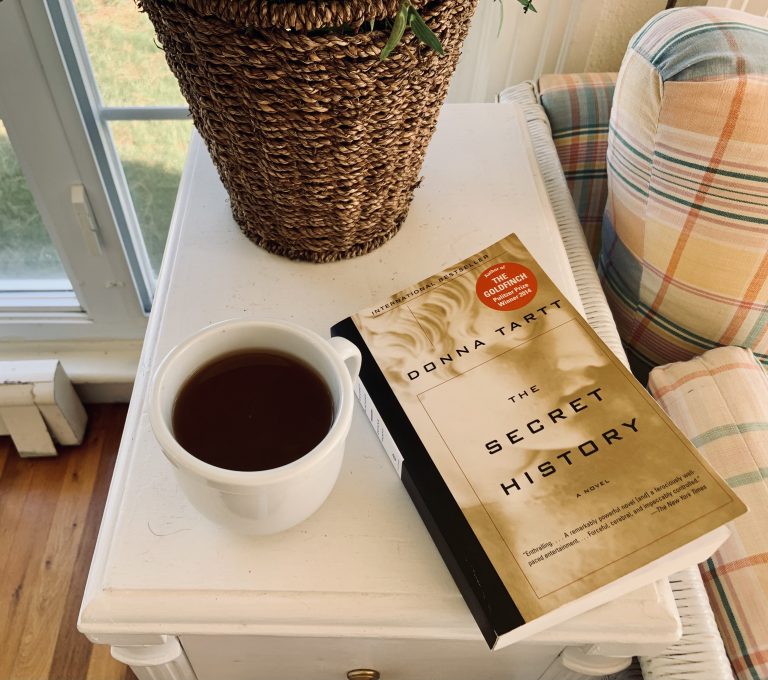“Does such a thing as ‘the fatal flaw,’ that showy dark crack running down the middle of a life, exist outside literature? I used to think it didn’t. Now I think it does. And I think that mine is this: a morbid longing for the picturesque at all costs.”
Donna Tartt, The Secret History
Dark academia can be characterized by a love of the classics and the pursuit of academic education. Think: dark, stony, gothic buildings, scholarly professors, and dusty libraries. Being that we’re now well into the autumn season, I was in the mood for a book that captured the essence of this aesthetic and was excited to start reading The Secret History by Donna Tartt. In this novel, Richard Papen is a transfer student at Hampden College. After some persistence, Richard gets the opportunity to take classes from Classics professor, Julian Morrow. There are only five other students when Richard joins their ranks. On the surface, they are the esteemed and privileged students of Hampden College. Though he is slowly accepted into their social circle, Richard feels that secrets are being kept from him. What begins as a strange educational experiment leads to a crime that must be kept secret at all costs. As he gets to know his peers better, he becomes a bystander to their heinous plans and watches as they turn on one of their own friends. Published in 1992, I was impressed that The Secret History felt simultaneously like a timeless classic and a contemporary novel. Though it is a great example of Dark Academia, don’t diminish this book to think it only fits an aesthetic: A Secret History is heavily influenced by the gothic literary tradition, depicting the characters’ descent into evil and analyzing the psychological repercussions of their choices.
In the first half of the book, the characters are like any friend group. Though they are a bit odd and share a tendency to act pretentious and even bigoted at times, I was fascinated and amused by the dynamics in this clique. Tartt has a great gift at creating natural dialogue and developing fully fleshed-out characters. Bunny, for example, was this jovial, New Englander type friend who could be quite obnoxious and tactless but was harmless. I could pinpoint the exact type of person he was based on similar boys I’ve come across in my life. The setting further enhanced my understanding of this friend group. The jaunts to Henry’s family estate in the country showed an idealized depiction of youth and privilege. The professor’s atypical learning environment felt natural and intimate, but also quite highbrow and scholarly. It seemed like the professor created a classroom setting where the students could really thrive.
The characters were always flawed and, at times, unlikable, but their decisions weren’t always dangerous. As the book progresses and the characters begin to make fatal choices, it becomes harder to sympathize with them. Still, even as their actions lead them to commit murder, I couldn’t help but worry they would get caught. The characters’ actions were believable because the author had great pacing. She knew that she had to slowly expose her characters in order to make it plausible that they would do such horrible things. As much as I loved reading this book, there are some chapters that lag. That being said, Tartt uses this time to dwell on the internal thoughts of the main character and allow a gradual culmination to the book’s climax. This book would not have been successful if the author didn’t take the time to create a believable descent from good to evil.
One of the most satisfying parts of reading this book was making the connections with this book to the gothic literary tradition. One example is the presence of twins which are a classic trope depicted in stories like The Fall of the House of Usher by Edgar Allan Poe. Tartt uses metaphors such as a cracked mirror and a disheveled apartment to reflect the twin’s crumbling relationship and internal turmoil. The natural surroundings in the country show the presence of the sublime, another tool in gothic literature. The dark and expansive woods (away from the college campus) are the place where the students are able to commit and cover up their crimes. Though I won’t go into further detail now, I would really love to take the time to research this topic further and write a full analysis on the gothic influences in this book.
I would give The Secret History a rating of 4.5 stars. If you’re a fan of Edgar Allan Poe, Ursula K. Le Guin, or Agatha Christie then you’ll really love this book. As I was reading, I was reminded of movies such as Dead Poet’s Society or The Riot Club. For those who struggle to become invested in a book but you like the Dark Academia aesthetic then you’ll probably feel that this book suits you. Though it’s a bold claim to make, I believe this book could stand the test of time and possibly join the ranks as a quintessential classic.
As always, I encourage you to consider buying from a local bookstore. Click the link below to purchase The Secret History from The Little Boho Bookshop in Bayonne, NJ: https://thelittlebohobookshop.com/searchtype=title&qs=the+secret+history&qs_file=&q=h.tviewer&using_sb=status&qsb=title


